Drawn By The Brush:
Oil Sketches by Rubens
by Robert Sievert
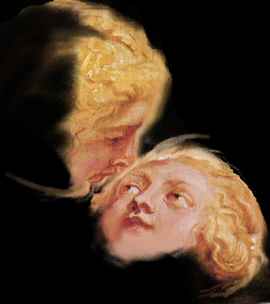
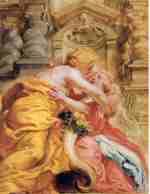
Rubens: Peace Embracing Plenty
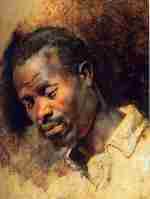
Rubens: Negro
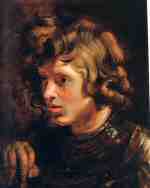
Rubens: Youth
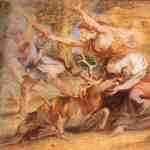
Rubens: The Hunt
|
DRAWN BY THE BRUSH Oil Sketches by Peter Paul Rubens Bruce Museum, Greenwich CT October 2, 2004--January 30, 2005 |
Peter Paul Rubens was a multitalented genius. He was perhaps one of the greatest figure artists ever, as well a diplomat, writer, and businessman who lived large in his time. You only have to see one or two of his major paintings to “get” him. Generous ample figures with loose but well formed anatomy were placed in dynamic compositions. A luminous, glowing use of color and light enhanced his brilliant sense of form..
Rubens traveled to Italy in his youth (1600-1609) and came into contact with oil sketches by the masters, Titian, Tinteretto and others. When he returned to Flanders he became renowned for his major compositions on religious and secular subjects. Oil sketches became a utile and integral part of his artistic repertoire. He prized these works above others. He guarded them jealously, not showing them to other artists, locking them up when not in use. They were his creative bases; he used some paintings again and again in his major commissions. They guided his assistants in the completion of major projects. He also used them to work out artistic problems. An oil sketch was far more durable than a paper drawing.
More to the point is that all this work was entirely drawn by brush. Until his time most paintings were carefully worked up from exacting drawings first done on the canvas. When he visited the Italian Masters they were developing the art of direct painting, improvising brush sketches.
In these paintings Rubens uses his brush to draw in the image. It is a tour-de-force of virtuosity. Again and again a brilliant simple sketch is brought to life with the addition of a few sweeps of the brush it some luminous tone that adds volume and depth. Worth repeating are the words of Julius Held quoted in the excellent catalogue accompanying the show: "Rubens never sought the impressionistic style of Tinteretto, pursuing instead a legibility of design and coherence of figural definition."
Most of these paintings fall into two categories, modello and bozzetto. The mondello was a formal presentation of a composition on small scale, while a bozzetto was usually a quick drawing on a prepared panel. More often a bozzetto was done on a dark ground and worked up to a light. This was mainly a compositional study.
Every one of these paintings is a jewel. Rubens raw skills as an artist are so clearly evident as each sketch is perfect in form and space as well as informed by a masters sense of light and color. What makes them of such great interest is that over his long career Rubens collaborated with many other artists such as Snyders, Jordaens and Van Dyck. So the issue becomes exactly what was Rubens's input. In the work seen here it is all Rubens.
Unbelievably hot is his painting PEACE EMBRACING PLENTY. Two great blonde beauties get it on in flowing silk robes that seem to be slipping off. They are seen from a lower viewpoint set against an architectural construction in which twisting and writhing columns mimic the forms of the embrace. The painting is fast and loose brought into focus by sharp definitive accent strokes. Everything works! The arms create the volume of the figures and the space between. The faces are intent upon each other and draw you into the seduction. The color of the work is exceptional, soft grays and sepias are the ground for the lush pinks and oranges of the figures. The overall effect of this painting is confection on the highest order
This extraordinary show will be at The Bruce Museum in Greenwich Connecticut from October 2, 2004 until January. There are about 42 works gathered here and will travel afterward to The Cincinnati Art Museum and then to the Berkeley Art Museum
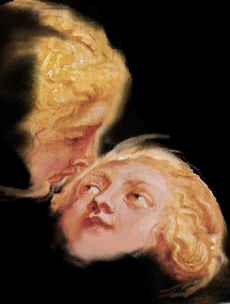
 back to Contents page
back to Contents page